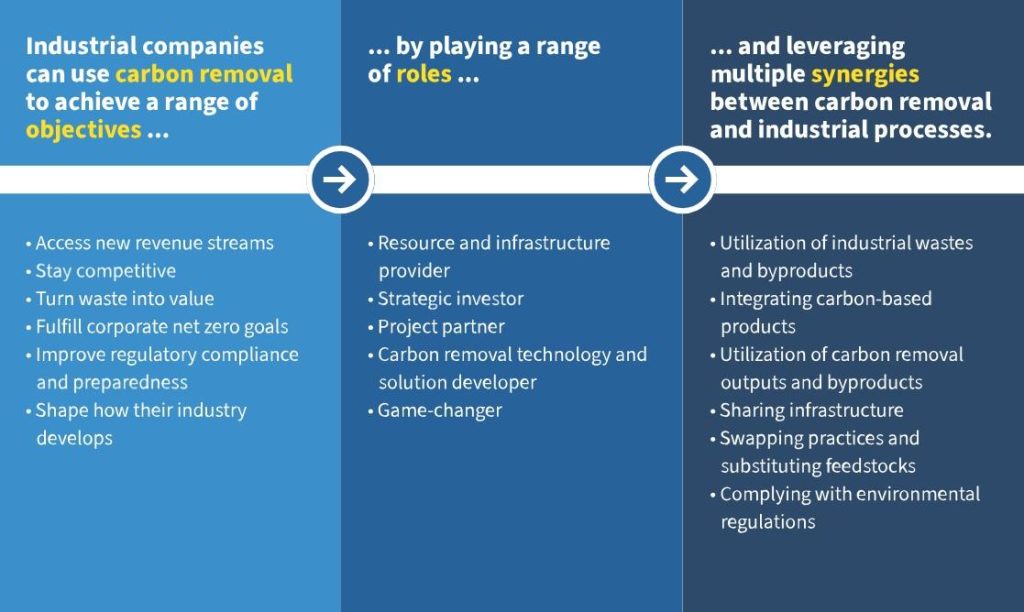By: Cara Maesano, Manager, Climate-Aligned Industries & Daniel Pike, Principal, Climate-Aligned Industries, RMI
There are both climate and commercial imperatives for heavy industry to pursue carbon removal — for first movers and early adopters especially, this can also be a strategic advantage.
Synergies with existing industrial processes present new opportunities to implement carbon removal methods as a means of improving efficiency, productivity, and revenue, while meeting regulatory demands.
RMI’s recent report, Seizing the Industrial Carbon Removal Opportunity, highlights the case for why industrial leaders should act now to develop and deploy carbon removal technologies within industrial value chains —and how doing so can deliver both environmental and economic returns.
Reason 1: Commercial and climate imperatives to support carbon removal are converging
Pressures on heavy industry to both reduce and remove emissions are intensifying due to evolving regulatory landscapes and shifting market demands. They will likely continue to increase over the coming decades. Developing and integrating carbon removal provides industrial companies with an additional and complementary set of tools for addressing these pressures. Initial piloting activities of carbon removal technologies, such as integrating carbon capture into desalination, pulp and paper, wastewater, and mining facilities, are showing that this does not necessarily need to cost industrial companies money. Proactive engagement with CDR offers tangible commercial opportunities, from improving efficiency, accessing nascent carbon markets, and generating green product premiums. It could also help mitigate future regulatory risks and potential carbon tax obligations. This isn’t just about environmental responsibility; it’s about smart commercial strategy in an uncertain world.
Reason 2: Industries can leverage existing assets and synergies to have impact
Incorporating carbon removal does not necessarily require radical overhauls or disruptive technologies. Our report highlights that many heavy industries possess underutilized assets and inherent synergies that can be leveraged for carbon removal and even further emissions reductions.
For example, waste streams from agriculture and forestry, construction and demolition, desalination, mining, steel, or wastewater processing can be put to use for long-term carbon removal and storage. Physical infrastructure in those industries and others can be made more productive by integrating CDR activities. This requires innovation in processes, operations, and business models. But it does not necessarily require scientific and technological leaps. Smart innovation within existing operational frameworks, using existing assets, can enhance early adopters’ near-term performance and long-term growth and resilience.
Reason 3: Investing now in carbon removal can future-proof your business
Investing in carbon removal now is an investment in future-proofing operations against a changing world and business environment. Relevant key trends include greater national prioritization of industrial innovation and growth, increasingly stringent environmental regulations, and growing markets for removing carbon from the air. Companies that proactively integrate carbon removal into their operations will be better informed on carbon removal technology and operationalization and better positioned to navigate these trends and maintain their relevance and competitiveness over the long haul.
How industries can get engaged with carbon removal
Here are the actionable steps heavy industries should consider:
Assess the carbon removal opportunity for your business, evaluating existing relevant operations and assets. Collaborate with other stakeholders to form new relationships and build knowledge. Invest in research, development and demonstration, allocating resources to pilot projects and demonstrations. Update your commercial goals to integrate carbon removal insights and create separate targets for decarbonization and carbon removal.
These steps will unlock opportunities to integrate carbon removal into existing industrial processes, drive greater efficiency, productivity, and help companies meet tightening regulatory requirements.

